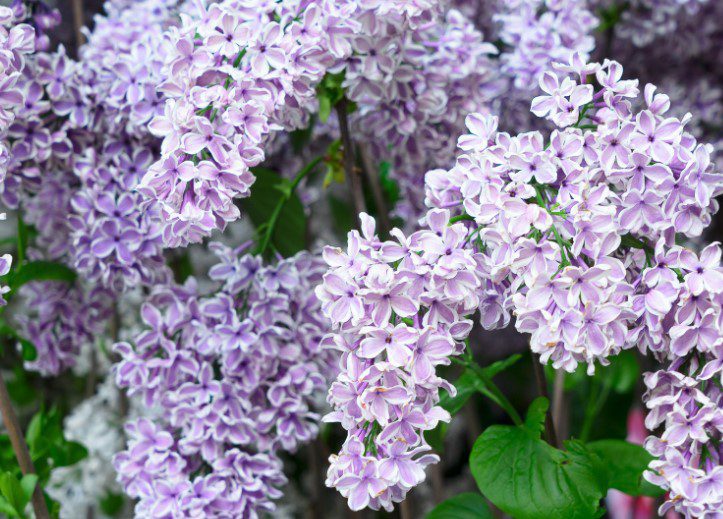Lilac Tree
Are lilacs shrubs or trees? It depends on which variety you choose. Both shrub lilacs, as well as bush lilacs, tend to be short and compact.
The lilac tree can be more difficult. A lilac tree is more than 13 feet (4m) high and has only one trunk.
Lilac trees grow to 25 feet (7.6m) tall and can have a tree-like appearance. However, their many stems make their bushes.
Although they aren’t technically trees, they can grow large enough to be considered trees.
Lilac Tree Care
By now, most lilac trees are looking a bit browned off as their faded blossoms dry out and leave behind a cluster of seed pods.
Allowing this to continue is one of the main causes of the gradual deterioration of quality in lilacs.
Flowers lose their vibrant colors, and the size and quantity of blooms diminish year after year.
To keep this popular plant looking its best, careful pruning should be done every year at about this time.
As soon as the flowers have finished their show, they should be chopped off not to set seed and weaken the plant for next year.
In some cases where a lilac tree has grown to giant proportions, you may need to use a clipper mounted on an extension pole to reach the top sections of the tree. Lower parts should be accessible with lopping shears or hand pruners.
Further pruning should consist of removing dead branches, older branches that are crowding out newer growth, branches that are crossed (especially if they are rubbing together), and any growth in the wrong place or headed in the wrong direction.
Grown too big
If a very old lilac tree has grown far too big for your requirements (and I see a lot of these around), a more drastic renovation will be needed.
This consists of cutting down major stems, some of them perhaps well over four inches (10 cm) in diameter, to a height below shoulder level.
Within a few years, the branches that will have re-sprouted near the top of this stump will bear flowers again, but this time where you can reach them.
If you are planning to renovate a tree with several tall stems, I’d advise cutting back only a third of them each year to not stress the tree too much in any one year.
Please take out the tallest one first, since it was probably shading the rest under it, then see how the plant looks next year before proceeding.
Tallest first
I have seen lilac trees as tall as two-story houses cut back drastically to almost ground level, and within a few seasons, they were covered with a dense globe of new flowering growth.
Other spring-flowering shrubs are also due for pruning right after they finish blooming.
Forsythia, spirea, honeysuckle, and weigela should all be trimmed when their flowers have faded, first of all, to remove the old blooms, and secondly to do any maintenance work you want.
That will leave the rest of the season for the plant to grow new wood, on which next year’s flowers will bloom. This is especially important if you plan on doing a lot of pruning back. If you leave the work until later, you risk adversely affecting next spring’s show.
Just as a matter of interest, if you have a forsythia bush that only bloomed on its lower half this spring, you’ve just seen an example of how tender they are.
The lower half was the only portion well protected by our poor snow coverage the past winter, keeping the freezing wind from affecting the flower buds.
Next winter, pile as much snow as possible over the plant, and you may be rewarded by a bush full of flowers the following spring.
Some of your hedges could do with maintenance clipping right now.
Both evergreen and non-flowering deciduous foliage will benefit from a light trimming each month from now until the end of August. Flowering types should be left until they have finished blooming. Otherwise, you’ll be cutting off this year’s show.
Careful trimming will stimulate growth in the cut areas, helping to thicken the coverage and making the hedge look neater.
If you’re cutting a long section of hedge, a string guideline to set the cutting level is a good idea. Otherwise, you will tend to cut deeper than you had planned to as your arms become more and more tired.
Always cut a hedge, so the top is narrower than the base. It doesn’t need to be a slope of more than 10 degrees, just enough to ensure that the lower reaches receive enough light and don’t end up losing leaves due to shading.
New shoots sprout
Deciduous hedge material can be cut back right into bare wood, as it will re-sprout new shoots very soon.
On the other hand, Evergreens should never be cut back into bare wood, as no new growth will occur from old wood, and you’ll be left with a bare stump.
If you haven’t already done so, a light feeding of all your hedges will benefit them greatly.
You can use a water-soluble fertilizer with a high nitrogen formula such as 15-5-5 mixed in a watering can or a hose-end spray applicator.
And while you’re at it, give the foliage a spray to clean it off and freshen it up for the hot weeks ahead.


























